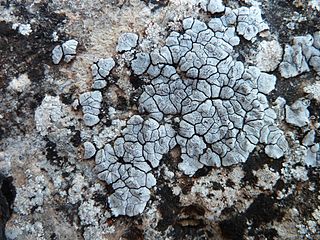
Placocarpus is a genus of lichens in the family Verrucariaceae. The genus was circumscribed by Italian botanist Vittore Benedetto Antonio Trevisan de Saint-Léon in 1860.

Perigrapha is a genus of fungi within the order Arthoniales that is parasitic on lichens. The genus has not been placed into a family.

Lecanora polytropa, the granite-speck rim lichen, is a species of saxicolous (rock-dwelling), crustose lichen in the family Lecanoraceae. A small, inconspicuous species that grows in the cracks of rock surfaces, it has a cosmopolitan distribution and has been recorded on all continents, including Antarctica.

Melaspilea is a genus of lichen-forming and lichenicolous fungi in the family Melaspileaceae. The genus was circumscribed by Finnish lichenologist William Nylander in 1857.

Stereocaulon alpinum is a species of fungus belonging to the family Stereocaulaceae. It is similar to Stereocaulon paschale but differs from it in containing cyanobacteria of the genus Nostoc while S. paschale contains cyanobacteria of the genus Stigonema, which have a darker colour than Nostoc.

Muellerella lichenicola is a species of lichenicolous fungus in the family Verrucariaceae. It was first formally described as a new species in 1826 by Søren Christian Sommerfelt, as Sphaeria lichenicola. David Leslie Hawksworth transferred it to the genus Muellerella in 1979.
Lichenopeltella cetrariae is a species of fungus belonging to the class Dothideomycetes. It has been found growing on Cetraria aculeata in Hrútey near Blönduós, Iceland and on Cetraria laevigata in Bulgan district, Mongolia and Toyama prefecture, Japan. In Japan, it has also been reported growing on Flavocetraria cucullata in Yamanashi prefecture and Nagano prefecture.
Tiina Randlane is an Estonian mycologist and lichenologist.
Lichenopeltella cladoniarum is a species of fungus belonging to the class Dothideomycetes. It has been found growing on the podetia of Cladonia arbuscula in Bulgan district, Mongolia and Yamanashi prefecture in Japan.

Candelariella aggregata is a species of lichen in the family Candelariaceae. It is found in western North America, Mongolia, and Switzerland where it grows on mosses and plant debris.
Clypeococcum bisporum is a species of lichenicolous (lichen-eating) fungus in the family Polycoccaceae. It is found in the Russian Far East, in Mongolia, and from northwest Alaska, where it grows parasitically on lichens from the genera Cetraria and Flavocetraria.
Endococcus hafellneri is a species of lichenicolous (lichen-eating) fungus in the family Verrucariaceae. It is found in North Asia and the Russian Far East, Estonia, and Japan, where it grows on the lobes of the lichens Flavocetraria cucullata and Cetraria islandica.

Bacidina pycnidiata is a species of crustose lichen in the family Ramalinaceae. It is widely distributed in Europe and North Asia. It is characterised by its whitish or cream-coloured pycnidia with long and ostiolar necks.
Lichenopeltella coppinsii is a species of lichenicolous fungus belonging to the class Dothideomycetes. It was described in 1999. It is known to infect Verrucaria muralis and has been reported from the British Isles, Ukraine, and Moshchny Island in the Baltic sea.
Stereocaulon depressum is a species of snow lichen belonging to the family Stereocaulaceae.
Stereocaulon groenlandicum is a species of snow lichen belonging to the family Stereocaulaceae.

Solorina crocea, commonly known as the orange chocolate chip lichen, is a species of terricolous (ground-dwelling) and foliose (leafy) lichen in the family Peltigeraceae. The lichen, which was first formally described by Carl Linnaeus in 1753, has an arctic–alpine and circumpolar distribution and occurs in Asia, Europe, North America, and New Zealand. It generally grows on the bare ground in sandy soils, often in moist soil near snow patches or seepage areas. Although several forms and varieties of the lichen have been proposed in its history, these are not considered to have any independent taxonomic significance.
Scutula stereocaulorum is a species of lichenicolous fungus in the family Ramalinaceae.

Tuckermannopsis orbata, commonly known as the variable wrinkle lichen, is a species of foliose lichen in the family Parmeliaceae. It is a small cetrarioid lichen, an informal growth form category that denotes lichens with erect, foliose thalli, and apothecia and pycnidia on the margins of the ruffled lobes. Tuckermannopsis orbata is found in Asia and North America, growing primarily on the wood and bark of mostly birch and coniferous tree branches and twigs.

Arctoparmelia incurva is a species of saxicolous (rock-dwelling), foliose lichen in the family Parmeliaceae. First described in 1794 by Christiaan Hendrik Persoon, it has undergone several taxonomic reclassifications before being placed in its current genus in 1986. This yellowish-green lichen, characterised by its narrow, convex lobes and globular soralia, typically grows on sun-exposed siliceous rocks in alpine and arctic habitats. It has a circumpolar distribution, found across North America, Europe, and parts of Asia. A. incurva can be distinguished from similar species by its specific morphological features and chemical spot test reactions. The lichen is known to host several parasitic fungi and has shown tolerance to acid pollution.











